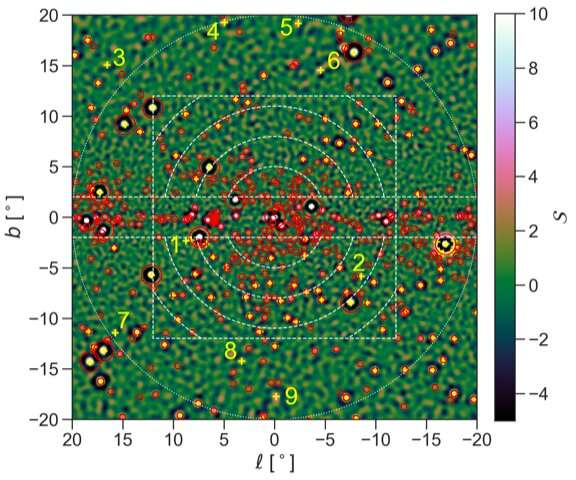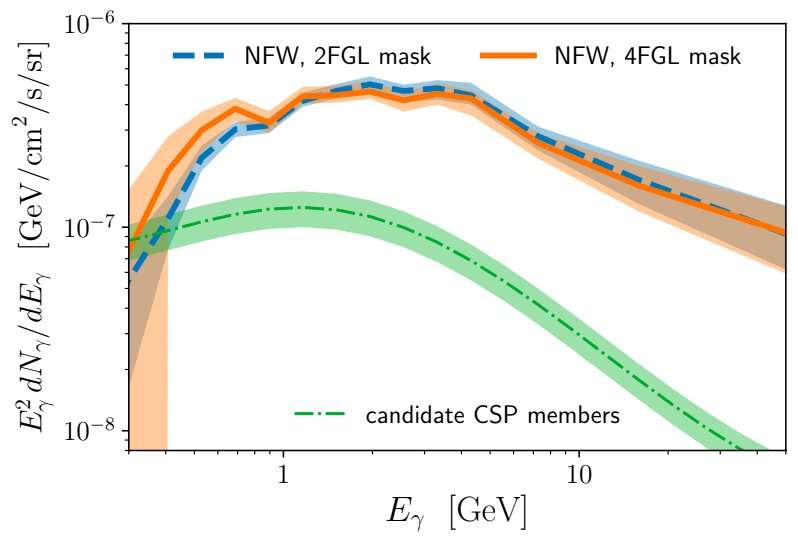Map of S½D. Peaks with S½D ≥ 4 in the region 2° ≤ jbj ≤ 20°; jlj ≤ 20° shown as crosses. 4FGL sources shown in red circles of size 0.3°ð1°Þ for 9 ≤ TS ≤ 49ð49 ≤ TSÞ. We find 8 sources (numbers 1 and 3–9) that have no 4FGL counterpart and one (number 2) that is sensitive to association proximity cut. The inner dashed lines show the angular regions used in Fig. 2; the outer dotted line shows the maximum extent of a region of projected galactocentric distance 3 kpc. See text for details. Credit: Zhong et al.
Over the past decade or so, a number of astrophysics studies have detected an excess of gamma-ray radiation at the center of our galaxy. Despite the many attempts to understand this unexpected surplus of radiation, now known as the galactic center excess (GCE), its source and the reasons why it exists remain unknown.
Initially, astronomers hypothesized that the GCE was associated with dark matter annihilation. More recent evidence, however, suggests that this excess in gamma-rays could be produced by a population of point sources (i.e., sources of energy), some of which may have already been observed in the past.
Researchers at University of Chicago, the Fermi National Accelerator Laboratory and Oakland University recently carried out a study aimed at investigating this possibility further by comparing past theories and observations with items within a point source catalogue compiled by the Fermi Large Area Telescope (Fermi-LAT) Collaboration. The results of their analyses, published in a paper published on Physical Review Letters, place new constraints on the ability of any previously detected point sources to underpin the GCE's smooth gamma-ray emission.
"Along with many of our colleagues we have been interested and intrigued by the galactic center excess (GCE) since it was first discovered almost 10 years ago," Yi-Ming Zhong, Samuel Mc Dermott, Ilias Cholis and Patrick Fox, the four researchers who carried out the study, told Phys.org via email. "This excess of gamma-ray emission towards the center of the Milky Way may be a signal of dark matter annihilation or originate from more conventional astrophysical mechanisms. For instance, a prominent astrophysical explanation for the GCE is that we observe the collective emission from remnants of massive stars that Fermi, with enough sensitivity, would observe as gamma-ray point sources."
The study carried out by the researchers builds on some of their previous works investigating the physical underpinnings of GCE. The key motivator behind their paper was that the Fermi collaboration recently updated its catalog of point sources (4FGL), which is essentially a list of all the light-emitting regions or bodies in the sky and the measurements associated with each of them.
The researchers had previously tested the hypothesis that the GCE originates from point sources by analyzing the Fermi collaboration's dim point sources database. Once the updated version was released, they set out to repeat their analyses on the newly collected data.
"We, and others, have applied the data analysis technique of wavelet decomposition to FERMI data in the past, usually focusing on information at large angular scales (large objects on the sky)," the researchers explained. "This time we wanted to apply it to small objects with the new catalog in hand."
Our best fit GCE with 2FGL mask (blue dashed curve) or 4FGL mask (orange solid curve), compared with the stacked spectra of 4FGL sources from our matched-filter search with S > 4, which are possibly members of a CSP (green dot-dashed curve). Credit: Zhong et al.
Understanding what phenomena take place at the center of the Milky way is an arduous and complex task, as many processes are going on at once, including formation of stars, supernovae that are extinguished, and the dynamics of central black holes. All these concurrent phenomena make determining the underlying structures of our galaxy via the analysis of gamma-ray measurements particularly challenging.
Wavelet decomposition is a technique that can separate various cosmological contributions based on the amount of space they take up in the sky. While it has often proved to be a very effective tool for analyzing a variety of images taken by telescopes, so far, very few research teams have applied it to the analysis of gamma-ray data. In their study, Zhong, McDermott, Cholis and Fox revisited an analysis carried out by three researchers at University of Amsterdam, who used wavelet decomposition to pick apart small objects in the sky (i.e., point sources) from other cosmological phenomena.
"More is known now about point sources in the direction of the Galactic center, both where they are and what they are," the researchers said. "In fact, the location of many of the newly measured point sources in the FERMI catalog were first uncovered by Bartels et al using wavelet techniques. History has repeated itself in that we have also found a few new bright spots in the sky that are not presently in other catalogs."
Previously, researchers suggested that some newly spotted point sources could offer an explanation for the GCE. As more information is gathered about these point sources, such as their spectra and whether they are located in the proximity of known astrophysical objects, this hypothesis can be tested further by comparing this data with GCE observations.
The new analyses carried out by Zhong, McDermott, Cholis and Fox show that none of the point sources included in the Fermi collaboration's updated 4FGL catalog can explain the GCE. Moreover, they suggest that if the GCE was actually made up of dim point sources, these would need to be a new class of cosmological objects and there would need to be several of them.
"We tried to determine the range of possibilities for the luminosity function for the dim point sources," the researchers said. "The range for parameters that would still fit the data are pretty extreme and not something one would have expected from the beginning. Thus, it seems to us unlikely that the GCE is coming from dim point sources and if it is, it would be coming from a new type of astrophysical source."
The new paper by Zhong, McDermott, Cholis and Fox presents new valuable results that somewhat limit the possibility of point sources underpinning the GCE, as suggested by a number of previous studies. These findings could serve as a basis for future research investigating the nature of the excess gamma-rays at the center of the Milky Way.
"We have some interesting ideas of how to use wavelets to help remove some of the more annoying backgrounds," the researchers said. "There is a healthy scientific discussion taking place in the field at the moment and based on feedback we have received we continue to refine our analysis of the point sources."
More information: Yi-Ming Zhong et al. Testing the Sensitivity of the Galactic Center Excess to the Point Source Mask, Physical Review Letters (2020). DOI: 10.1103/PhysRevLett.124.231103
Journal information: Physical Review Letters
© 2020 Science X Network

























